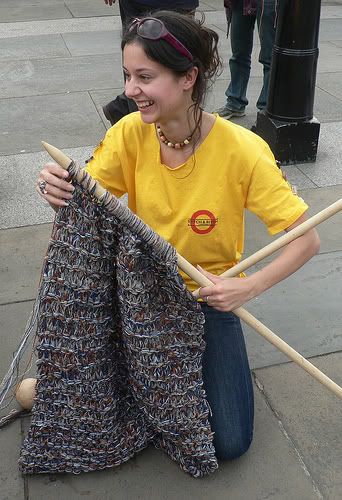
As it's summer there's less need for big wooly jumpers and scarves, so it seemed like the perfect time for knitting models of my favourite insect - ladybirds. The pattern is really easy...
Materials: 2.5mm needles; red and black double knit yarn (doesn't have to be anything fancy); 1 darning needle, stuffing.
Cast on 3 stitches
Row 1: starting with red yarn, purl 3
Row 2: k1, m1, k1, m1, k1 = 5 stitches (RS)
Row 3: purl 5 (WS)
Row 4: k1, m1 alternately until you have 9 stitches
Row 5: purl 9
Row 6: k1, m1 alternately until you have 17 stitches
Row 7: purl 17
Row 8: k1, m1, k15, m1, k1 = 19 stitches
Row9: purl 19 stitches
Row 10: k1, m1, k15, m1, k1 = 21 stitches
Row 11: p21
Rows 12 to 28 St st
Row 29: k1, k2tog, k15, k2tog, k1 = 19 stitches
Row 30: p19
Row 31: k1, k2tog, k13, k2tog, k1 = 17 stitches
Row 32: p17
Row 33: change to black yarn, k1, k2tog, k11, k2tog, k1
Row 34: p15
Row 35: k1, k2tog, k9, k2tog, k1 = 13 stitches
Row 36: p13
Row 37: k1, k2tog, k7, k2tog, k1 = 11 stitches
Row 38: p11
Row 39: k1, k2tog, k5, k2tog, k1 = 9 stitches
Row 40: p9
Row 41: k1, k2tog, k3, k2tog, k1 = 7 stitches
Row 42: k1, k2tog, k1, k2tog, k1 = 5 stitches
Row 43: Cast off purl wise
This gives you the top of the ladybird.
Underneath side:
Cast on 6 stitches
Row 1: Purl (WS)
Row 2: k1, m1, k4, m1, k1 = 8 stitches (RS)
Row 3: p8
Row 4: k1, m1, k6, m1, k1 = 10 stitches
Row 5: p10
Row 6: increase as above = 12 stitches
Row 7: p12
Row 8: increase as above = 14 stitches
Row 9: p14
Rows 10-13: St st
Row 14: Increase as above = 16
Row 15: P
Row 16: k16
Row 17: p16
Row 18: k16
Row 19: p16
Row 20: k16
Row 21: p1, p2tog, p12, p2tog, p1 = 14 stitches
Row 22: decrease as above knitwise = 12 stitches
Row 23: p12
Row 24: decrease as above knitwise = 10 stitches
Row 25: decrease as above purlwise = 8 stitches
Row 26: decrease as above knitwise = 6 stitches
Row 27: p6
Row 28: K2, k2tog, k2
Row 29: p5
Row 30: k5
Row 31: p2tog, p2, p2tog = 3 stitches
Cast off
Now, using the black yarn, make the ladybird pattern on the top side of the ladybird (a black line through the middle and vlack dots, see picture)
Now, holding the two pieces against one another (RS facing one another), sew togther, three quarters of the way around the perimeter, turn the right way out and stuff the ladybird. Then sew up the remainder of the seam. And now you have your very own knitted ladybird! You can also sew a broach pin to the back, so that it can be pinned to your favourite bag or cardigan.










 Plain Knitted Hair Band
Plain Knitted Hair Band







 There is so much to see and do in Tokyo, if you have a limited time you will certainly not see it all. Apparently there is a Hello Kitty Museum (I think it's called Kitty Land). I didn't get to visit, but to be honest I don't think I needed to - Hello Kitty is everywhere in Japan. You can buy clothes, dolls, jewellery, umbrellas, phone pendants and much much more, all with the cute little kitty on. In fact, the most useful word I learnt in Japanese is 'kawaii' - cute. Everything in Japan is cute.
There is so much to see and do in Tokyo, if you have a limited time you will certainly not see it all. Apparently there is a Hello Kitty Museum (I think it's called Kitty Land). I didn't get to visit, but to be honest I don't think I needed to - Hello Kitty is everywhere in Japan. You can buy clothes, dolls, jewellery, umbrellas, phone pendants and much much more, all with the cute little kitty on. In fact, the most useful word I learnt in Japanese is 'kawaii' - cute. Everything in Japan is cute.


















